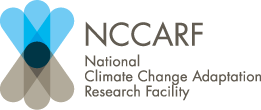You are here
Adaptation on track
Sydney Trains has developed a climate change risk assessment and adaptation masterplan, identifying the main risks that climate change poses to its rail infrastructure, services and customers. Adaptation action underway includes the installation of concrete sleepers and tension-regulated overhead wiring, as well as lightning protection infrastructure.
Leading the assessment program is Chris Royal, Sydney Trains’ Environmental Specialist.
Chris explains, ‘I began by setting out a clear scope of what we needed to achieve, and specifically what evidence-based information was required to drive adaptation. This included examining a couple of hundred potential risks that had been identified in the scientific literature and refining them to ones that we have strong evidence for. I then quantified and ranked the economic, social, safety and environmental costs of each critical risk under current conditions and with the projected impacts of climate change up to 2100, whilst accounting for the design life of operational assets and the requirements of customers.’
‘Due to its wide geographical spread, significant array of critical asset types and functions, and growth in customer demand, the rail network is often highly exposed to a variety of extreme weather events. Larger scale risks in the medium- to long-term come from sea-level rise in coastal regions, bushfires and extreme temperatures. For example, we introduce speed limits on parts of the rail network during extremely hot days. That can have knock on effects, causing delays across the network.’
‘Lightning strikes have often been the prime cause of delays. Some climate projections suggest that a hotter climate may lead to a significant increase in lightning strikes, with potential impacts to our electrical equipment, signalling, and communication and control centres. Even an indirect strike 50 metres away from some infrastructure can cause problems.’
Sydney Trains has initiated a suite of adaptation strategies, including lightning protection programs, advanced weather warning systems that provides emergency response staff with warning of extreme events via mobile apps, and climate resilient asset management strategies. Sydney Trains have replaced many timber sleepers with concrete to minimise track movements due to extreme weather events, and implemented heat-resilient tension-regulated overhead wiring.
‘Landslides and rock falls associated with drier soils and more rainfall extremes could also cause problems. We have excellent monitoring of geotechnical elements and therefore the likelihood of significant impacts is low, but the consequences are potentially very significant.’
‘An additional identified risk is the damage caused by wind-blown material. We’ve had people’s roofs blow onto our tracks, trees fall onto electrical infrastructure, and even a boat blown into our overhead wiring!’
‘Flooding is one of our biggest risks. We have regular extreme rainfall events that flood stations and underground infrastructure. We’re implementing adaptation strategies to deal with concerns about more extreme events.’
In recognition of his work, Chris Royal was presented with a Climate Adaptation Champion award at the 2016 NCCARF CSIRO Climate Adaptation Conference in Adelaide.
How do transport disruptions affect your organisation?
Does your organisation have plans in place for days of extreme heat?
o2yc35un831c3ojz.png





